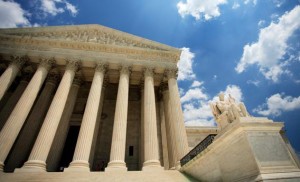Some Canadian Bacon Is More Equal than Some Carnitas
The funny thing about this Josh Marshall column against (other peoples’) dual citizenship is that he didn’t need to go to the issue of dual citizenship at all. He wrote it in response to a proposal to let NYC non-citizens vote in municipal elections.
I’m curious to hear what you think about the New York City Council proposal to let non-citizens vote in municipal elections. To me, it’s definitely a bad idea.
But as part of his effort to explain his concept of “thick citizenship” he goes there: condemning the legal status of dual citizenship for Latino immigrants but not, apparently, for Canadian (and Israeli) ones.
If Latin American immigrants maintain citizenship in the countries of their birth, doesn’t that undermine the claim to full equality here?
[snip]
Now, as a practical matter I know there are people who carry dual citizenship because of very practical reasons like child custody and basic convenience for bi-national families. My wife is probably arguably a dual citizen simply because there’s no obvious way to renounce her original citizenship in the country of her birth. So I don’t see people who have dual US-Canadian citizenship as some great threat to the commonwealth or something or something that we actively need to eliminate. It’s basically a non-problem. But I think it would be a bad thing if it became more pervasive – which is something that I think is possible as the free flow of peoples becomes easier and more common.
As a reminder, I’m a dual citizen, having gotten Irish citizenship before they made doing so much more onerous some years ago, because of the possibility that at some point my Irish spouse and I might move somewhere in the EU (though not necessarily Ireland — funny how that works).
Perhaps it offends the Irish that an American, seven-eighths of whose ancestors were Irish, whose Irish forebears left Ireland before some of my spouse’s arrived there, now has legal paperwork that permits her to live and work in Ireland (and the rest of the EU), not to mention go through either line at customs in Dublin. They’ve never said that, though. They do, however, complain about the East Europeans who came to Ireland as cheap workers during the Tiger era and have made it their thick citizenship home. Curiously, they sometimes tell my cousin — who lives and works for an “thick citizenship” NGO in Ireland but doesn’t have citizenship — she has “returned,” I guess because Irish-Americans never stop being Irish.
There’s a difference, it seems, between nationality and citizenship.
Now, not only have I not ever voted in an Irish election (they don’t allow absentee voting, but boy would I if I could), neither has my spouse, in part because he has lived in Japan or the US almost from the time he could vote. That’s the way pre-Celtic Tiger Ireland was (and is again, increasingly). Mr EW has, however, engaged in a number of activities that would fall under Marshall’s “thick citizenship” category here in the US (with about five exceptions, though, only if I dragged him along kicking and screaming).
So my response to the substance of Marshall’s post is this: I’m agnostic on non-citizen voting at the local level (though I think it beats the hell out of what we have here in MI, where inner city citizens are being stripped of their municipal franchise left and right, and I think it’s a way to encourage thick citizenship). I think thick citizenship is a good thing for everyone where ever they live — it’s a fundamental part of building community, and the more we integrate all contributors of our local society into its thick citizenship, the more we’ll develop both the local and global empathy we need to get along in this world. And I think thick citizenship and legal citizenship are entirely different things (as demonstrated by both my cousin and my spouse, engaging in thick citizenship in countries where they’re not citizens). It’d be nice if the former had some tie to the latter, but as it is, we really only demand minimal competence in citizenship from immigrants, not from kids raised and schooled here.
Legal citizenship may be how we draw boundaries around the legal entrees to thick citizenship (though we often exclude felons even though they’re citizens), but it is also at least as much about how one legally negotiates daily life, particularly economic life, which is one reason so many people retain dual citizenship.
But all that’s what I think about the larger points in Marshall’s post.
It’s the underlying logic, though, of suggesting that there’s no problem with Canadians retaining dual citizenship but there is for “Latin American” immigrants.
Some pigs are more equal than other pigs.
Does Marshall include Mexico in that category which, like Canada, is part of NAFTA, and provides far more people who serve as America’s cheap labor but also (because of our immigration preferences) tends to create lifestyles that require splitting families across borders? Does it foster “thick citizenship” if a farm worker and union member who lives most of the year in California has to choose between engaging in legal citizenship in the country he lives most of the time or the country where his wife and kids live (and he sends remittances)? Are our national interests so divorced from those of Mexico (but not Canada!?!) that we need to maintain strict unitary citizenship only for those from the south, in spite of how closely tied our countries have become. Why? Is there some common “white Anglo” culture, one which hasn’t been enriched by the Latino heritage of much of the US?
A poor Latino immigrant — or even a poor white working class American — gains power against rich (often white) people through a combination of thick citizenship and legal citizenship rights. To suggest just Latinos should have additional barriers to gain those legal rights out of some sense they’re more likely to have divided loyalties than Canadians only serves to strengthen the rich white people by comparison.
More importantly, though, the US is so powerful, has such an overriding influence on the daily lives of poor people all over the world, and our daily life has become so globalized, it seems we’d do well to expand the fluidity of citizenship, not curtail it. If we affluent white Americans felt more common citizenship with the Mexicans who pick our food or the Bangladeshis who make our clothing, we might be a lot more embarrassed about the ways we benefit from their exploitation.
If we don’t share “thick citizenship” with the people whose lives we affect so negatively, then it’s not doing the work it needs to.







